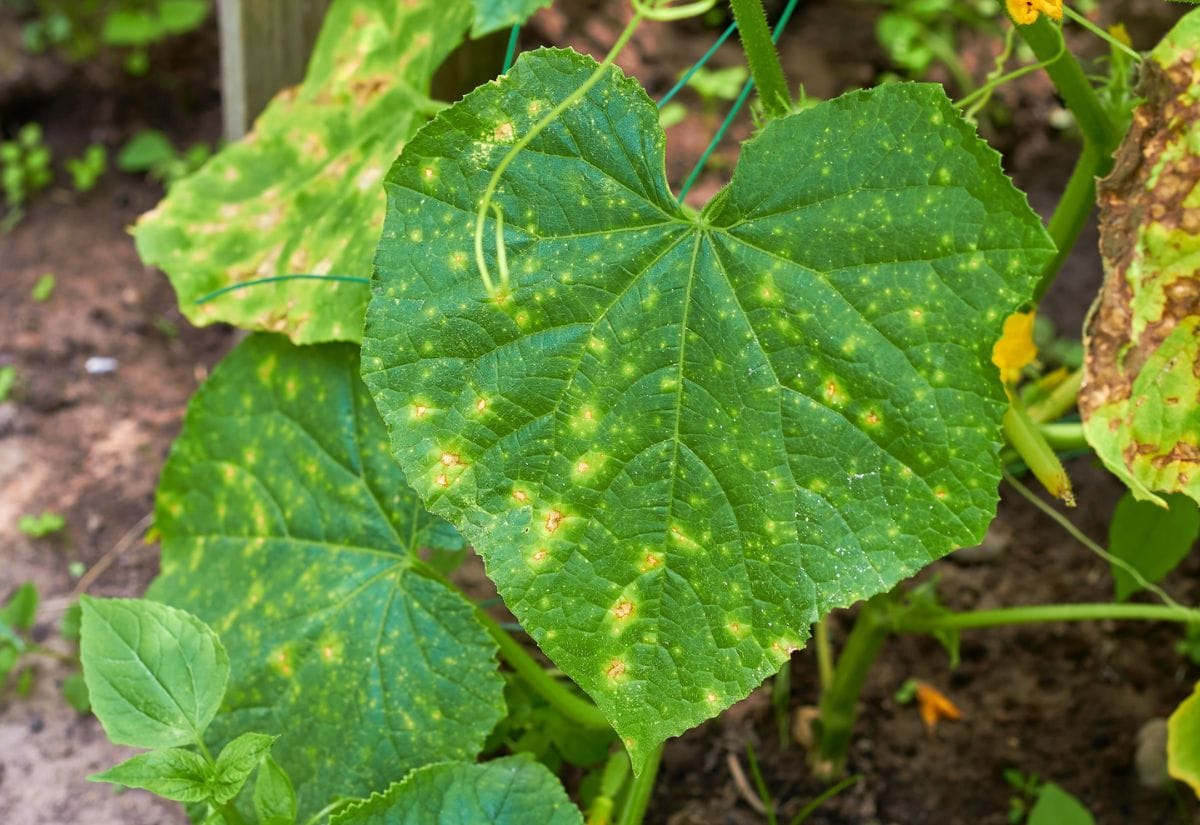
One of the joys of growing cucurbits like cucumbers is searching amongst the massive foliage for the delectable vegetables hiding underneath.
But sometimes, your search turns up something more unpleasant: yellow spots on the leaves of your cucumbers.
Yellow spots on cucumber leaves typically suggest potential issues. These can range from fungal infections like downy mildew to viral diseases like cucumber mosaic virus. Pests that is feeding on your plants such as mites, aphids, and whiteflies might also be the culprits. Additionally, magnesium deficiency or Alternaria (late blight) can also lead to these yellow spots.
At the onset, they might not seem like much at first, these issues can retard growth, reduce yield, or even kill your plant if left untended.
While fungal diseases and viruses are incurable, insects and magnesium deficiency can be treated and cured.
Even so, with careful management, these issues can be prevented in the first place so the only surprise you will get this growing season is how big your harvest is.
Let’s take a look at how to identify what is causing yellow spots on your cucumber’s leaves, and how to naturally manage these problems.
Why Yellow Spots on Cucumber Leaves Are a Cause for Concern?
So why are yellow spots a bad thing? Sometimes a yellow spot can simply be a damaged leaf, or a wandering bug took a bit as he was passing by, but sometimes the yellow spots can be indicative of something far more problematic.
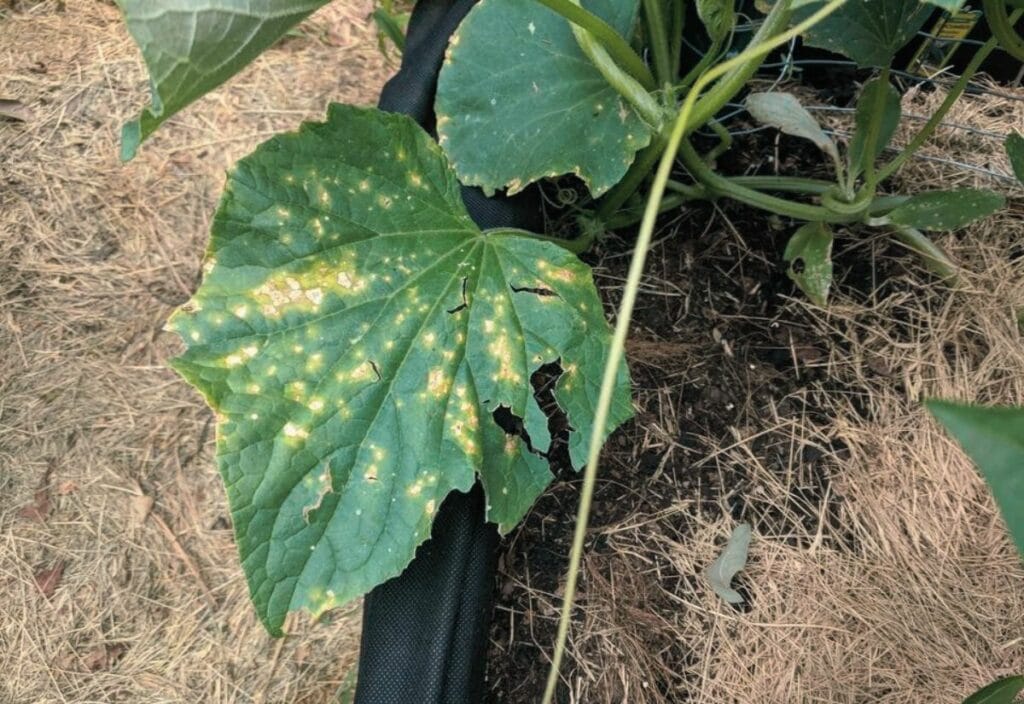
Yellow spots could be caused by:
Plants need nice green leave to properly photosynthesis sunlight into plant food. Yellow spots reduce the plant’s ability to make this food which will inhibit the plant’s growth, reduce its yield, or lead to its premature demise.
7 Reasons Why Your Cucumber Leaves Have Yellow Spots and How to Remedy Them
So, when you see yellow spots on the leaves, you want to quickly identify what is causing them so you can rectify the problem before it gets serious. Yellow spots on cucumber leaves can be caused by:
1: Downy Mildew
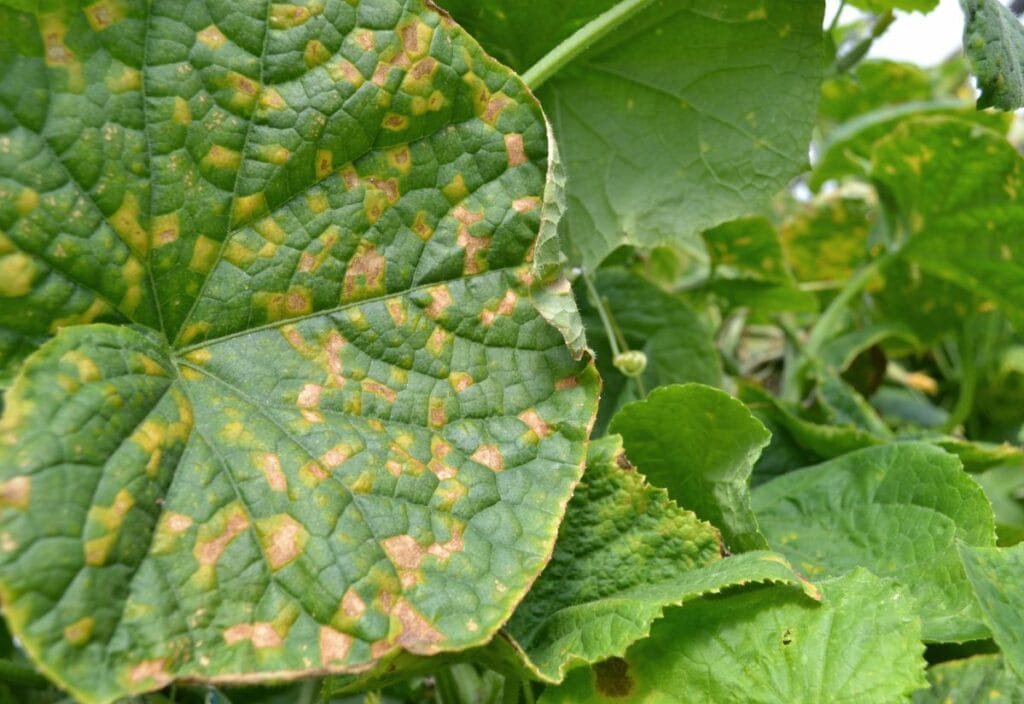
Downy mildew can cause spots of several different colours depending on the variety of the pathogen and which type of plant is infected. On cucumbers, however, the pathogen will cause chlorotic spots. The symptoms of downy mildew are:
Downy mildew is an Oomycete, or a water mould, which is a fungal-like disease that affects the foliage of the cucumbers. It is a widespread fungus that infects many plants, including everything in the cucurbit family.
However, it is particularly devastating to cucumbers. Downy mildew will spread through the air, splash on the plants from contaminated soil, or can transfer mechanically (by hands, tools, or clothing).
Downy mildew requires living green plant matter to survive on, so in cold climates, it will die after frosts or extreme cold. However, it can produce oospores, which are resting spores that can survive extreme temperatures for up to ten years.
Downy mildew requires moisture (at least 85% relative humidity) to attach itself to the leaves and to breed and spread, so it is most prevalent during wet summers. New spores are produced on the underside of the leaves where they then travel to other leaves and plants.
It is viable through a wide range of temperatures, from 5°C to 30°C (41-86°F), but it mostly flourishes between 15°C and 20°C (59-68°F).
How To Prevent
With a bit of careful planning, you can keep downy mildew from taking hold of your cucumbers by:
How To Treat Downy Mildew
Downy mildew cannot be cured once it takes hold of your plants, so prevention is the best line of defence. There are a few fungicides available for downy mildew, but these chemicals can cause serious environmental damage. Not to mention that downy mildew is becoming resistant due to the excessive use of these fungicides.
2: Alternaria (Early Blight)
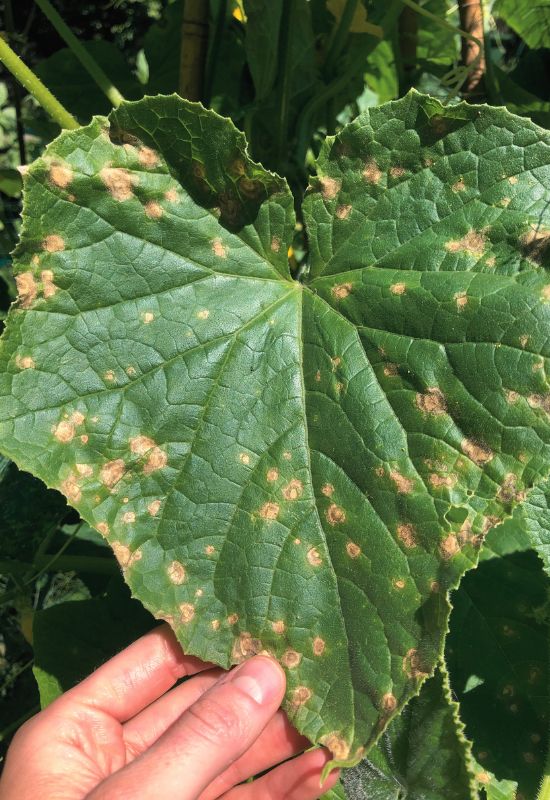
Alternaria does not produce true yellow spots. Instead, it develops brown dead spots on the leaves that are surrounded by a chlorotic halo. You can tell Alternaria apart from other fungal diseases by:
Alternaria, or early blight, is a common disease found in many gardens. Cucumbers are infected by the Alternaria cucumerina variety which is sometimes called cucumber blight.
Unlike many other fungal pathogens, Alternaria prefers warm temperatures. It is active from 15°C (59°F), but it grows and spreads most easily between 27°C to 30°C (82-86°F).
Alternaria spores can enter your garden through infected seeds or transplants, but once there is can spread by wind, insects, splashing water, or on your tools. It can also survive for up to two years on infected plant matter.
Alternaria can affect all parts of the plant, including the leaves, stems, and fruits. While Alternaria will stunt the growth of the plant and reduce its yield, it rarely becomes severe enough to kill the plant.
How To Prevent Alternaria
The best way to protect your cucumbers from Alternaria is to keep your plants from getting it in the first place.
Check out the list of preventative measures above to keep all fungal diseases away from your cucumbers.
How To Treat Alternaria
Like downy mildew, there is no way to cure Alternaria. Since fungal diseases are essentially untreatable, prevention is your best option.
3: Cucumber Mosaic Virus
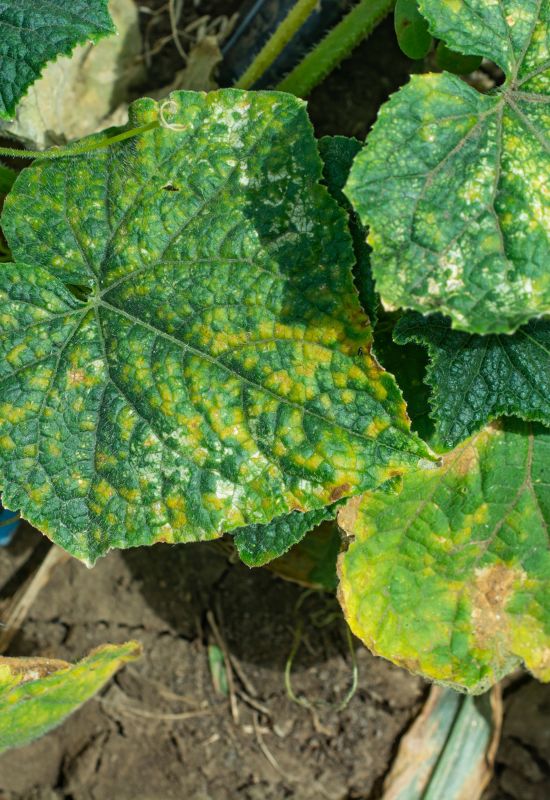
Cucumber mosaic virus (CMV) was so named because it was first identified on a cucumber plant, yet it can infect lots of different plants in the garden. The most common symptoms include:
Cucumber mosaic virus won’t often kill the plants. However, the entire plant’s growth will be stunted and your yield will be reduced with distorted cucumbers.
Viruses, like cucumber mosaic virus, cannot spread on their own. You can spread cucumber mosaic virus on your hands or tools, but it is most commonly spread via aphids (see all the other issues aphids can cause and how to control them below).
Once the virus has entered the plant’s cells, it will spread and quickly infect the entire plant. In many cases, once symptoms are first seen, the entire plant is already infected with the disease.
How To Prevent Cucumber Mosaic Virus
CMV can devastate the garden once it takes hold. Here are the best ways to protect your plants from becoming infected in the first place:
How To Treat Cucumber Mosaic Virus
There is no way to cure a plant from CMV. The only course of action to eliminate the virus is to completely cull any infected plants that you identify.
Do not add culled plants to your compost, as the virus can survive through the composting process to reinfect your garden.
Pruning is not an effective method of control since the rest of the plant will probably be infected by the virus even if those parts do not have symptoms.
Studies have found that the only part of the plant that did not contain the virus were cells in new growth points at the tip of the plant.
Make sure to clean any equipment and wash your hands after working with infected plants.
4: Mites
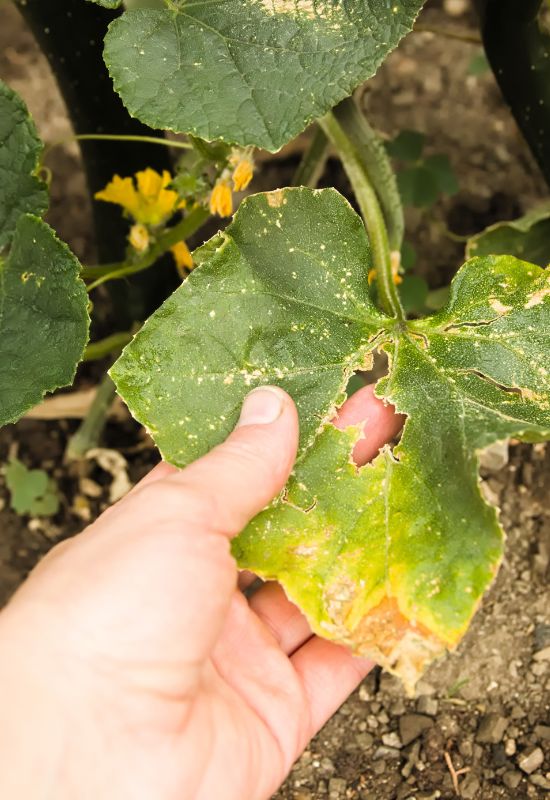
Cucumber plants are one of mites’ favorite sources of food. You can tell you have mites if you see:
Mites have eight legs and two distinct body parts so these tiny arachnids are often called ‘spider’ mites, and they can be red, brown, or black. They feed on plants by biting the leaves and sucking out the juices,
which is what causes the incision spots to turn yellow and dry. They can also inject a toxin into the plant which causes further discolouration and stunted growth.
Mites can be tiny (0.5-1mm long)], making them very difficult to see on the leaf. In our area, most mites are red, making them a little easier to see, but if you suspect mites
but cannot see them, try tapping the leaves onto a piece of white paper to make it easier to see the small insects. Also, it might be time to bring out the magnifying glass.
They can reproduce quickly since a single female can lay up to 20 eggs per day for her several-week-long adult life. Furthermore, the eggs can still produce male mites without the female mating. They will overwinter in cold gardens as eggs or mated females.
Mites prefer dry and hot conditions so they can be a real pain in the summer. However, this can also be used to our advantage.
How To Prevent Mites
Before mites even arrive, there are some things you can do to make your garden less appealing to these critters.
How To Treat Mites
Once the mites have arrived, there are a few things you can do.
5: Aphids
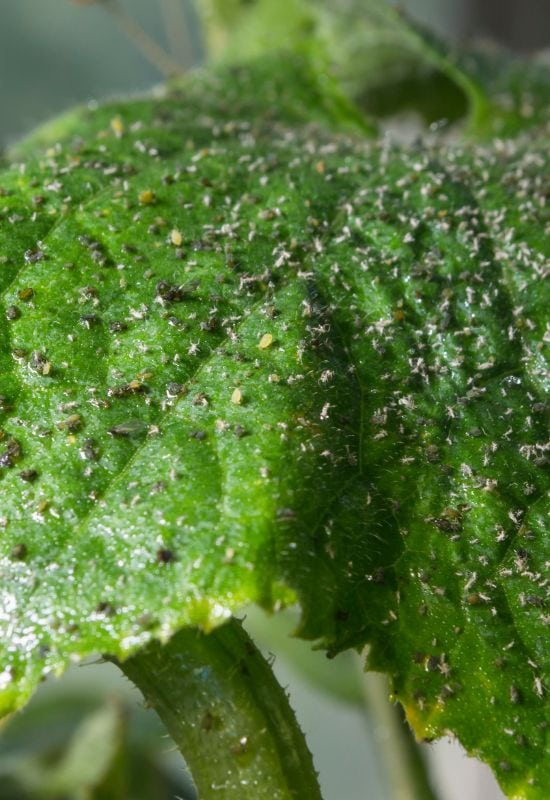
Swarms of aphids may seem harmless, but they can actually cause a lot of problems. Aphids can be identified from other bugs by:
Most people see aphids as green, but they can be a range of colours. Each species can be winged or wingless, and all species can produce asexually, so a single aphid can soon turn into a big problem. They usually cause the most damage in late spring, but they can infect your cucumbers all year long.
Aphids will secrete a sticky substance called honeydew that sticks to the leaves. Honeydew can inhibit photosynthesis, and sooty mould fungus can stick to it causing further damage to your cucumbers. And, of course, aphids are carriers of CMV (see above).
Several species of ants will become aphid herders. They will protect the aphids from predators and move them around to the healthiest parts of a leaf.
The ants will even carry the aphids to their ant hills at nighttime and overwinter them there. In return, the ants will rub the aphids with their antennae to “milk” them of their honeydew which they then consume.
How To Prevent Aphids
There are a number of ways to keep aphids from your cucumbers:
How To Treat Aphid Infestations
6: Whitefly
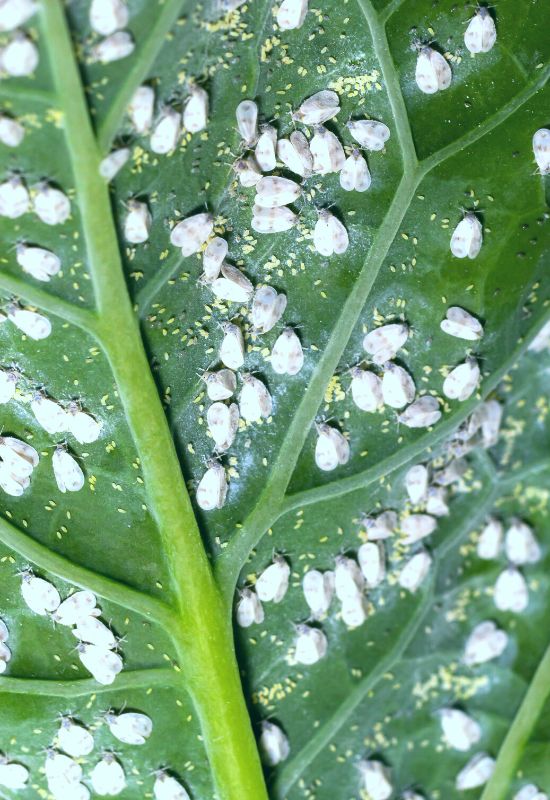
Whiteflies are closely related to aphids, but they can be identified by:
Whiteflies are not actually flies, and they are most active during the day. They are most active in mid to late summer and like hot, humid weather.
Like their aphid cousins, they feed on sap from the leaves and cause chlorosis, reduce photosynthesis, and inhibit growth.
How To Prevent Whiteflies
Whiteflies can be prevented in much the same way as aphids and mites:
Hot To Treat Whiteflies
Whiteflies can also be gotten rid of in similar ways as aphids.
7: Magnesium deficiency
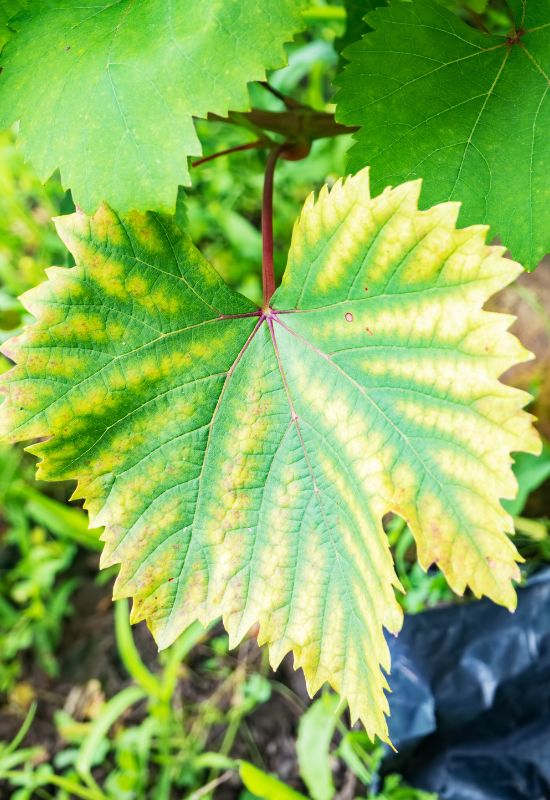
Lack of magnesium can also cause yellow spotting on cucumber leaves.
How To Prevent Magnesium Chlorosis
Making sure your soil is nicely balanced with all the essential nutrients is important. Here are some ways to prevent your cucumbers from becoming deficient in magnesium.
How To Treat Magnesium Deficiencies
If your cucumbers are developing yellow spots from too little magnesium, then you will need to act quickly to rectify the problem before it goes too far.
Don’t Let Yellow Spots Ruin Your Plants
Yellow spots can be a sign of a major problem lurking in your garden. But when these yellow spots show up, don’t worry.
The symptoms are easy to tell apart and once you know what you are dealing with, then you can act quickly and naturally so you will be rewarded with a bountiful crop of nice, crispy cucumbers.

Written By
Amber Noyes
Amber Noyes was born and raised in a suburban California town, San Mateo. She holds a master’s degree in horticulture from the University of California as well as a BS in Biology from the University of San Francisco. With experience working on an organic farm, water conservation research, farmers’ markets, and plant nursery, she understands what makes plants thrive and how we can better understand the connection between microclimate and plant health. When she’s not on the land, Amber loves informing people of new ideas/things related to gardening, especially organic gardening, houseplants, and growing plants in a small space.

Thank you